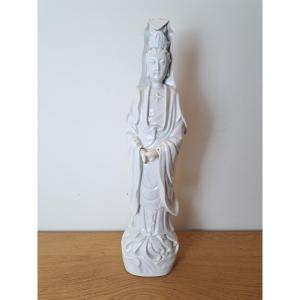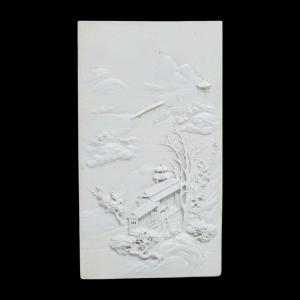Her attire, consisting of skirt, jacket, shawls and collars, is adorned with a stunning variety of oriental motifs, including phoenix birds, stylized flowers and geometric borders. These are rendered in a vibrant color palette ranging from soft jade greens to deep reds and purples. In her right hand, she gracefully holds a hexagonal tray containing a ceremonial cup surrounded by finely modelled and enameled flowers. Some petals show minor wear, almost unnoticeable, which only enhances the piece’s authenticity and age.
The serene facial expression, with finely outlined eyes, individually painted eyebrows and softly curved lips, radiates introspective calm. Her hair, carefully modeled in low relief, adds texture and realism. On the back of the kimono, phoenixes fly over stylized waves, meticulously painted using dense, precise brushstrokes.
The figure stands atop a base composed of superimposed colorful disks, perhaps ceremonial mats or cushions, which enhance the sense of richness and stability. Inside the hollow base is a six-character Chinese seal mark, likely from the workshop or the artist, a prized feature among collectors.
A magnificent piece for refined collectors and lovers of Asian decorative arts. This figurine will look outstanding in any setting, whether as a centerpiece in a cabinet or as a stand-alone highlight in your living space.
Dimensions: 47.5 × 19 cm (18.70 × 7.48 in)
History of Qing Porcelain
Porcelain from the Qing dynasty, 1644–1912, especially that made in the 18th and 19th centuries, is widely recognized for its exceptional technical and artistic quality. During this time, the imperial kilns of Jingdezhen reached peak refinement, mastering multicolor enameling and combining relief work with intricate hand painting. Porcelain became a powerful form of cultural expression, imbued with symbolism and technical mastery.
Representations of idealized women, usually court ladies or servants carrying trays of flowers or offerings, became widespread. The phoenix, as depicted here, symbolizes rebirth and immortality and is associated with the Empress. A six-character seal mark at the base commonly indicated the workshop or dynasty and denoted a higher artistic standard, especially for export.
This figurine perfectly illustrates the ornamental style of late 19th-century China, when traditional forms still dominated despite growing Western influence. Highly prized then and now, these works are considered cultural treasures and valuable collector’s items.














































 Le Magazine de PROANTIC
Le Magazine de PROANTIC TRÉSORS Magazine
TRÉSORS Magazine Rivista Artiquariato
Rivista Artiquariato